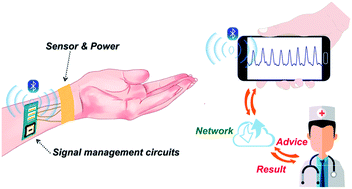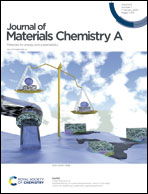Active-powering pressure-sensing fabric devices†
Abstract
Smart flexible sensing devices with high-comfort and self-powered characteristics are essential in the future-generation wearable human-sensing interface. However, most of the current sensing devices cannot work independently and require external power. Here, we introduced for the first time an active-powering pressure-sensing fabric (APPS) device, integrating a soft-matter battery unit with a fabric-based sensing substrate into one flexible device architecture, which offered a comfortable and reliable human-sensing interface with continuous system powering capacity for wearable physiological and activity monitoring. Notably, the APPS fabric demonstrated an open voltage of 1 V, short circuit of 35 mA cm−2 and capacity of 2.6 mA h cm−2. The specifically designed solid neutral hydrogel electrolyte showed high safety and high force-resistance, guaranteeing the stability of the power output under pressure. Moreover, it exhibited the highest sensitivity of 19.6 Ω−1 kPa−1 in a test pressure range (of <300 kPa) and a mechanical response time of 9 ms. For wearable applications, we packaged the APPS fabric into an adhesive bandage format, from which a series of pressure detection demonstrations were successfully implemented without using any power source. In particular, the APPS fabric device could power the whole system by itself for signal detection and wireless data transmission via a Bluetooth or LED. Benefitting from the unique properties of the active powering and its remarkable performance, the APPS device holds an enormous potential for emerging wearable applications, including health monitoring, gesture recognition and motion monitoring.



 Please wait while we load your content...
Please wait while we load your content...